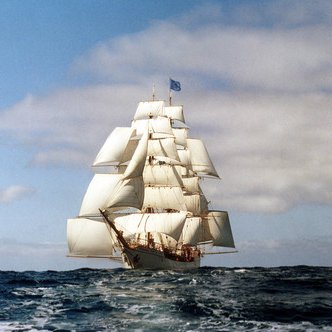Sailing towards Tristan da Cunha

Good speed sailing the backing strong winds between Lows and Highs. Sailing with dolphins and our first contact with the Tristan seabirds and Tristan.
Well, not the island yet, but today it seems we got to the forging grounds of the Tristan Archipelago seabirds.
Still 850nm of open oceanic waters are ahead, but this was the day that the Tristan birds came out in force. As we sleepily arose on deck for our watch, masters of the air circled and swerved the ship.
Endemism. Today’s most repeated word out on deck while, binoculars and cameras at hand, many join to enjoy the numerous seabirds that gracefully soar around the ship.
All of a sudden, from the lower diversity spotted yesterday, today we wake up surrounded by many more species, several of them with very restricted nesting grounds, to just the Tristan da Cunha Archipelago (Tristan, Inaccessible, Nightingale and Gough Islands).
Native from the islands are the Atlantic petrels, quite stocky looking birds, all dark brown but with white belly. They fly long distances away and can be found along the Polar Front in the south Atlantic. A bit of a surprise was to come across a solitary Tristan skua, hundreds of miles from land. Commonly regarded as a subspecies of the Subantarctic skua, they are also endemic to Tristan island group, with a total population of about 12000 pairs.
But without doubt two species were today’s highlights. For the first time on our crossing we have seen Spectacled petrels, not just native from the archipelago but even with a much more restricted area where they nest, being endemic to Inaccessible Island only, and classified as a critically endangered species. It was great to see them in groups following the ship for hours.
The other native species that attracted many looks was the majestic Tristan albatross. From the wandering albatross family, they are a bit smaller in average, with a wingspan of 3 meters, and some other slight differences, such as the ways that they got a lighter colour pattern with the age, for instance Tristan albatross females don’t get so white with the age as the males or other subspecies of wanderers.
Great shearwaters flew around us too. These ones with a breeding ground that includes Tristan group plus a small percentage of them nesting in Falklands. One of their amazing habits is their migratory patterns. Off the breeding season, they can be found all the way to Iceland and South Greenland.
‘The further from home we might feel ourselves to be, the more at home they are.’
- The Seabird’s Cry, Adam Nicolson
Another bird that nests in Tristan group but also in other remote sub Antarctic islands all around the Southern Ocean is the Great winged petrel. Of a similar uniform dark colour it's the most elegant bird of all. It appears at a bit of a distance from the ship and doesn’t come too close. But when it does a semicircular, a white eye-ring can be seen, together with and thin yellow line on the beak. Its wings and tail are long, slender and pointed. Its wingspan is just about 2 meters, small for an albatross, though we are talking about the beautiful Sooty albatross. They breed in a number of islands in the South Atlantic and south Indian Ocean, including Tristan archipelago, but they are not very numerous, they are considered as an endangered species, with a total population estimate of 10500 to 14300 breeding pairs.

Then, a hop and splash at the bow- the waves' patterns broken by a torpedo of flesh and bone. Shadows in the water. The glimpse of a fin. Dusky dolphins dove out from a towering wave and shot into our bow wake. Our adrenaline matched theirs as they burst through the churning and hopped alongside our steel hull. Known for their agility, these dolphins ride bow waves apparently for fun, staying for as long as the ship is fast enough to entertain them. Today, as Europa surged forward, a group of about 30 individuals remained leaping and slamming through the sea for 45 minutes while we watched in amazement.
Melon-headed, with reduced beaks and sleek bodies, broad tailstocks of muscle for powerful propulsion, the dolphins are so perfectly equipped for the breaking waves that we felt pangs of envy at their enjoyment of a race we will never be able to run.
Great shearwaters rode the gusts above them, relishing the air as much as the dolphins did the waves. Maybe the birds were watching this strange interaction of species, dolphins alongside strange aliens to their environment, all equally curious to one another. Maybe they were hoping for the commotion to produce some easy prey. Either way- their perspective worlds away from ours, dolphins on a liquid planet, us on a small world of steel and sail, the birds one of briny air.





